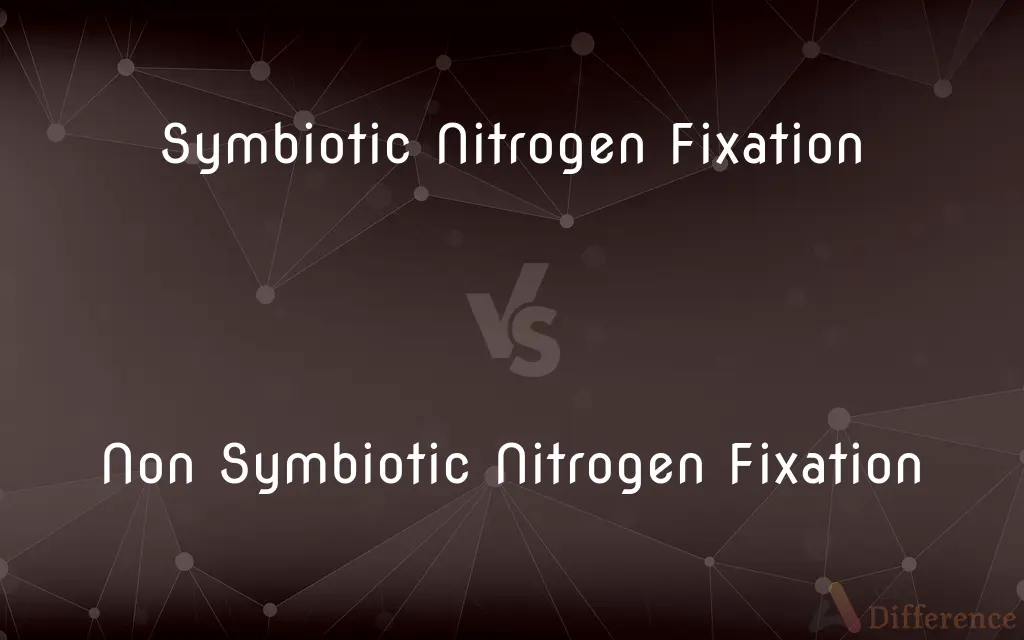Symbiotic Nitrogen Fixation vs. Non Symbiotic Nitrogen Fixation — What's the Difference?
By Tayyaba Rehman — Published on December 21, 2023
Symbiotic Nitrogen Fixation involves a partnership between plants and bacteria. Non-Symbiotic Nitrogen Fixation occurs independently by certain bacteria. Both processes convert atmospheric nitrogen to usable forms for plants.

Difference Between Symbiotic Nitrogen Fixation and Non Symbiotic Nitrogen Fixation
Table of Contents
ADVERTISEMENT
Key Differences
Symbiotic Nitrogen Fixation and Non-Symbiotic Nitrogen Fixation are essential mechanisms for converting atmospheric nitrogen into forms that plants can use. Symbiotic Nitrogen Fixation refers to a mutualistic relationship between specific bacteria and certain plants, primarily legumes. In this partnership, bacteria fix atmospheric nitrogen, providing the host plant with nitrogen compounds, while the plant offers sugars and a suitable environment for the bacteria.
Contrarily, Non-Symbiotic Nitrogen Fixation does not involve such partnerships. Instead, free-living bacteria in the soil, not associated with any particular plant, carry out this process. These bacteria capture and convert atmospheric nitrogen independently, releasing it into the soil, benefiting many plants indirectly. While both processes serve the same end goal, their methods and relationships differ substantially.
Symbiotic Nitrogen Fixation is notably efficient and localized. The plant directly benefits from this relationship, obtaining a steady supply of fixed nitrogen right at its roots. Nodules, specialized structures on plant roots, house these symbiotic bacteria, facilitating this direct nutrient exchange. In contrast, Non-Symbiotic Nitrogen Fixation is more generalized. While it benefits a broader range of plants, it might not be as efficient as its symbiotic counterpart because it lacks the intimate exchange present in symbiotic relationships.
In essence, while Symbiotic Nitrogen Fixation and Non-Symbiotic Nitrogen Fixation both play vital roles in the nitrogen cycle and agriculture, they represent different biological relationships and efficiencies. The former is a direct, mutualistic relationship, while the latter is an independent action by free-living bacteria.
Comparison Chart
Involves Relationship?
Yes, mutualistic between plants and bacteria
No, carried out by free-living bacteria
ADVERTISEMENT
Main Organisms
Leguminous plants and Rhizobium bacteria
Azotobacter and Clostridium bacteria
Location
In root nodules
In soil, independent of specific plants
Efficiency
Highly efficient due to direct exchange
Less efficient than symbiotic processes
Beneficial to Specific Plants?
Primarily to the host plant
Benefits a wider range of plants indirectly
Compare with Definitions
Symbiotic Nitrogen Fixation
Conversion of atmospheric nitrogen in plant root nodules.
The nodules on pea plant roots facilitate Symbiotic Nitrogen Fixation.
Non Symbiotic Nitrogen Fixation
Conversion of atmospheric nitrogen independent of specific plants.
Azotobacter in the soil performs Non-Symbiotic Nitrogen Fixation.
Symbiotic Nitrogen Fixation
Efficient nutrient exchange between host plant and bacteria.
Through Symbiotic Nitrogen Fixation, soybeans obtain necessary nitrogen compounds.
Non Symbiotic Nitrogen Fixation
Generally less efficient than its symbiotic counterpart.
While valuable, Non-Symbiotic Nitrogen Fixation might not match the direct benefits of symbiotic methods.
Symbiotic Nitrogen Fixation
Directly benefits the host plant with a steady nitrogen supply.
Thanks to Symbiotic Nitrogen Fixation, chickpeas don't require much nitrogenous fertilizer.
Non Symbiotic Nitrogen Fixation
Occurs without specialized structures like root nodules.
Free-living bacteria in soil can carry out Non-Symbiotic Nitrogen Fixation anywhere.
Symbiotic Nitrogen Fixation
A mutualistic relationship between plants and bacteria for nitrogen fixation.
Legume crops benefit directly from Symbiotic Nitrogen Fixation.
Non Symbiotic Nitrogen Fixation
Nitrogen fixation by free-living bacteria, not in partnership with plants.
Non-Symbiotic Nitrogen Fixation enriches the soil for various crops.
Symbiotic Nitrogen Fixation
A specialized mechanism primarily involving leguminous plants.
Beans engage in Symbiotic Nitrogen Fixation with Rhizobium bacteria.
Non Symbiotic Nitrogen Fixation
Benefits a broad range of plants indirectly through soil enrichment.
Crops planted after a fallow period can benefit from prior Non-Symbiotic Nitrogen Fixation.
Common Curiosities
Which type of bacteria commonly engage in Non-Symbiotic Nitrogen Fixation?
Bacteria like Azotobacter and Clostridium.
What's the primary relationship in Symbiotic Nitrogen Fixation?
It's a mutualistic relationship between specific bacteria and plants, mainly legumes.
Where does Symbiotic Nitrogen Fixation occur in plants?
Within specialized structures on plant roots called nodules.
Do Non-Symbiotic Nitrogen Fixation bacteria form partnerships with plants?
No, they fix nitrogen independently in the soil.
Do both processes contribute to the nitrogen cycle?
Yes, both play vital roles in replenishing soil nitrogen.
Can any plant engage in Non-Symbiotic Nitrogen Fixation?
No, it's the free-living bacteria in the soil that perform Non-Symbiotic Nitrogen Fixation.
Why is Symbiotic Nitrogen Fixation considered efficient?
Because of the direct exchange of nutrients between the host plant and bacteria.
How do plants get nitrogen from Non-Symbiotic Nitrogen Fixation?
The fixed nitrogen enriches the soil, indirectly benefiting various plants.
What's a notable benefit of Symbiotic Nitrogen Fixation for agriculture?
Reduced need for nitrogenous fertilizers for crops like legumes.
Which process is more general in benefiting plants?
Non-Symbiotic Nitrogen Fixation, as it enriches the soil without favoring specific plants.
Can crops like beans get nitrogen without Symbiotic Nitrogen Fixation?
While beans primarily rely on it, they can also absorb nitrogen from soil enriched by other sources.
Is human intervention necessary for Non-Symbiotic Nitrogen Fixation?
No, it naturally occurs with free-living bacteria in the soil.
Is Non-Symbiotic Nitrogen Fixation limited to certain soil types?
It can occur in various soils but depends on the presence and activity of specific bacteria.
Which fixation process directly involves root nodules?
Symbiotic Nitrogen Fixation involves root nodules housing the symbiotic bacteria.
How does Symbiotic Nitrogen Fixation impact ecological balance?
It promotes sustainable agriculture by reducing the need for synthetic nitrogen fertilizers.
Share Your Discovery

Previous Comparison
Bazaar vs. Flea Market
Next Comparison
Gradualism Equilibrium vs. Punctuated EquilibriumAuthor Spotlight
Written by
Tayyaba RehmanTayyaba Rehman is a distinguished writer, currently serving as a primary contributor to askdifference.com. As a researcher in semantics and etymology, Tayyaba's passion for the complexity of languages and their distinctions has found a perfect home on the platform. Tayyaba delves into the intricacies of language, distinguishing between commonly confused words and phrases, thereby providing clarity for readers worldwide.













































